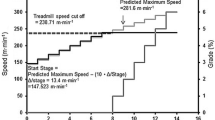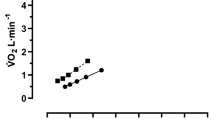Abstract
Aim
Portable devices that accurately detect the composition of expired gases and changes in VO2 open new possibilities in research methodology and accessibility.
Purpose
The purpose of this study was to compare the oxygen consumption (VO2) measurements of the VO2 Master Pro (VM) to the Cosmed K5 (K5) during walking, jogging, and running in field and lab conditions.
Methods
Twelve proficient runners, with a current 10 k pace of ≥ 11.29 km/h, performed 3 matched intervals at 3 different speeds (4.82, 8.05, 11.29 km/h) on a treadmill and on an outdoor track. An airflow test was also performed on both devices by pumping air through the devices using a 3 L syringe timed to a metronome at 15, 25, and 35 beats/min.
Results
The VM did not report walking data for most participants. During treadmill running, there were significant differences in VO2 (47.86 ± 3.94 vs. 29.56 ± 4.15 mL/kg/min), ventilation (Ve) (71 vs. 57 mL/min), and tidal volume (TV) (1.89 vs. 1.56 L) between the K5 and VM respectively (P < 0.05). Outdoor analysis also showed significant differences between devices in VO2, Ve, and TV (P < 0.05). The airflow test showed significant differences between the devices in Ve and TV (P < 0.05).
Conclusion
These results suggest that there are significant discrepancies between the K5 and the VM, likely due to differences in TV measurement.







Similar content being viewed by others
References
American College of Sports Medicine. ACSM’s Guidelines for Exercise Testing and Prescription. 10th ed. Indiana: Lippincott Williams & Wilkins; 2008.
Baldari C, Meucci M, Bolletta F, Gallotta MC, Emerenziani GP, Guidetti L. Accuracy and reliability of COSMED K5 portable metabolic device versus simulating system. Sport Sci Health. 2015;11(S1):S58.
Cooke CB, McDonagh MJN, Nevill AM, Davies CTM. Effects of load on oxygen intake in trained boys and men during treadmill running. J Appl Physiol. 1991;71(4):1237–44. https://doi.org/10.1152/jappl.1991.71.4.1237.
Crouter SE, LaMunion SR, Hibbing PR, Kaplan AS, Bassett DR. Accuracy of the Cosmed K5 portable calorimeter. PLoS ONE. 2019;14(12):1–14. https://doi.org/10.1371/journal.pone.0226290.
Fagundes ADO, Monteiro EP, Franzoni LT, Fraga BS, Pantoja PD, Fischer G, Peyré-Tartaruga LA. Effects of load carriage on physiological determinants in adventure racers. PLoS ONE. 2017;12(12):1–13. https://doi.org/10.1371/journal.pone.0189516.
Guidetti L, Meucci M, Bolletta F, Emerenziani GP, Gallotta MC, Baldari C. Validity, reliability and minimum detectable change of COSMED K5 portable gas exchange system in breath-by-breath mode. PLoS ONE. 2018;13(12):1–12. https://doi.org/10.1371/journal.pone.0209925.
Macfarlane DJ. Open-circuit respirometry: a historical review of portable gas analysis systems. Eur J Appl Physiol. 2017;117(12):1–18. https://doi.org/10.1007/s00421-017-3716-8.
Montoye AHK, Vondrasek JD, Hancock JB. Validity and reliability of the VO2 master pro for oxygen consumption and ventilation assessment. Int J Exerc Sci. 2020;13(4):1382–401.
Perez-Suarez I, Martin-Rincon M, Gonzalez-Henriquez JJ, Fezzardi C, Perez-Regalado S, Galvan-Alvarez V, Calbet JAL. Accuracy and precision of the COSMED k5 portable analyser. Front Physiol. 2018;9:1–12. https://doi.org/10.3389/fphys.2018.01764.
Sieber A. Oxygen sensor technology for rebreathers. Orlando: Rebreather; 2014. pp. 185–202.
Winkert K, Kirsten J, Dreyhaupt J, Steinacker JM, Treff G. The COSMED K5 in breath-by-breath and mixing chamber mode at low to high intensities. Med Sci Sports Exerc. 2020;52(5):1153–62. https://doi.org/10.1249/MSS.0000000000002241.
Author information
Authors and Affiliations
Contributions
All authors contributed to the conceptualization and study design. AT & PD conducted data collection and analysis. AT prepared the first manuscript draft. All authors contributed to data interpretation and edits of the manuscript. All authors approved of the final manuscript.
Corresponding author
Ethics declarations
Conflicts of interest
The authors report no conflicts of interest or competing interests.
Ethics approval
This study was approved by the university institutional review board.
Consent to participate
All participants provided written informed consent.
Consent for publication
All authors approved of the final draft of the manuscript. Participants consented to publication of de-identified data.
Availability of data and material
Not applicable.
Code availability
Not applicable.
Rights and permissions
About this article
Cite this article
Toulouse, A., Joubert, D., Oden, G. et al. Comparison of the VO2 Master Pro and Cosmed K5 During Walking, Jogging, and Running. J. of SCI. IN SPORT AND EXERCISE 4, 119–127 (2022). https://doi.org/10.1007/s42978-021-00146-w
Received:
Accepted:
Published:
Issue Date:
DOI: https://doi.org/10.1007/s42978-021-00146-w




